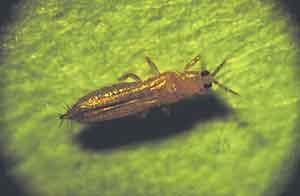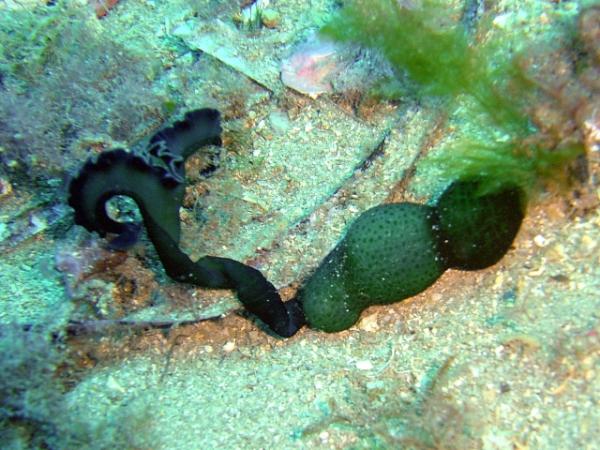| Nature's Most Outrageous Reproductive Acts |
| Written by Jonathan C. Wojcik - Photo credits unknown or from public news articles unless otherwise noted. If you know their sources and need them credited or removed, please e-mail me. |
Survival in the natural world ultimately comes down to only two principles: feed and reproduce. By
now, you should know how some organisms murder and enslave other creatures for their own
propagation, brood young in their own flesh or keep thousands of mates in their own
bodies, but situations such as these are just a glimmer of the Animal kingdom's most morbid
perversions. Like the secret myspace blog of a schoolteacher, Mother Nature hides her darkest
fetishes in some of the most cryptic and unlikely places...
now, you should know how some organisms murder and enslave other creatures for their own
propagation, brood young in their own flesh or keep thousands of mates in their own
bodies, but situations such as these are just a glimmer of the Animal kingdom's most morbid
perversions. Like the secret myspace blog of a schoolteacher, Mother Nature hides her darkest
fetishes in some of the most cryptic and unlikely places...
| Ceratoid Anglerfish: Parasitic Husbands |
I've already touched upon male Ceratoids here, but this list just wouldn't be complete
without their presence, and you can never show off too many photos of their lovely lifestyle.
without their presence, and you can never show off too many photos of their lovely lifestyle.
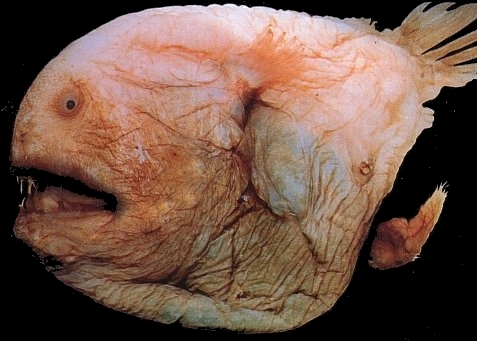
| A large female Ceratoid with a smaller, attached male. |
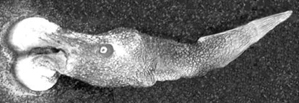
Finding a mate can be tough in the eternal darkness of the deep ocean, so when a tiny
male anglerfish encounters a female, he clings to her body with his jaws for an extended
period of time, and in some species, permanently. An enzyme is released to dissolve his
lips, melting his face into the skin of his mate while he subsists on her blood. Eventually
they will merge on the circulatory level, transforming the male into a body part of the
female. His eyes, brain and other organs may gradually atrophy, leaving only the gonads
to produce sperm as necessary.
male anglerfish encounters a female, he clings to her body with his jaws for an extended
period of time, and in some species, permanently. An enzyme is released to dissolve his
lips, melting his face into the skin of his mate while he subsists on her blood. Eventually
they will merge on the circulatory level, transforming the male into a body part of the
female. His eyes, brain and other organs may gradually atrophy, leaving only the gonads
to produce sperm as necessary.
| Deep-sea Squid: Live Ammunition |
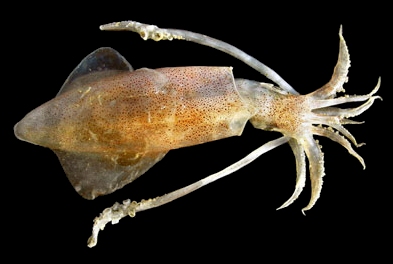
When it comes to certain squid - including some of the world's largest - the smaller,
weaker male is more likely to end up in the female's stomach than her heart. Since it can
be difficult to line up reproductive organs in the middle of a cannibalistic death-match, the
female is receptive to sperm almost anywhere on her body, and the male need only inject
it under her flesh. In species like Taningia danae, the male may inflict wounds with his
beak to deposit sperm packets (spermatophores) more than two inches deep.
weaker male is more likely to end up in the female's stomach than her heart. Since it can
be difficult to line up reproductive organs in the middle of a cannibalistic death-match, the
female is receptive to sperm almost anywhere on her body, and the male need only inject
it under her flesh. In species like Taningia danae, the male may inflict wounds with his
beak to deposit sperm packets (spermatophores) more than two inches deep.
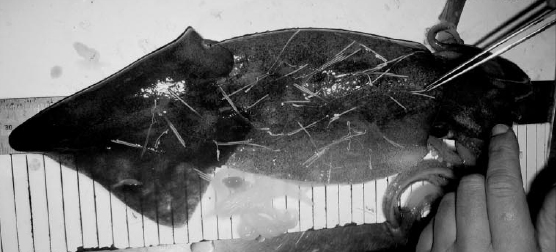
In others, like Moroteuthis ingens, the spermatophores are complicated arrow-like
mechanisms "shot" into the female's body, where they dig themselves deeper with an
enzyme secretion before most of the mechanism is discarded. Mistakes are not
uncommon, with sperm-missiles frequently found embedded in other males or even in
such useless locations as eyeballs.
mechanisms "shot" into the female's body, where they dig themselves deeper with an
enzyme secretion before most of the mechanism is discarded. Mistakes are not
uncommon, with sperm-missiles frequently found embedded in other males or even in
such useless locations as eyeballs.
| Green Spoon Worm: Internal Affairs |
Spoonworms or Echiurans are bizarre sand-dwellers usually distinguished by a fat,
cucumber-like body and a forked, ribbon-like feeding proboscis that can stretch to
incredible lengths as it vacuums food from the ocean floor. Most of their reproductive
habits are poorly understood, but at least one species, Bonellia viridis, has exhibited a
form of dimorphism even odder than the Anglerfish. When a sexless, microscopic larva
touches down on unoccupied sand, it begins a gradual transformation into a large female
over the course of many years. Most larvae, however, will end up following the scent of an
already-mature female. Contact with her skin will "masculinise" the larvae, who remain
microscopic in size but develop into fertile males crawling on her body. She will eventually
suck them through her proboscis and into her genital sac, where they will spend the rest of
their lives parasitically.
cucumber-like body and a forked, ribbon-like feeding proboscis that can stretch to
incredible lengths as it vacuums food from the ocean floor. Most of their reproductive
habits are poorly understood, but at least one species, Bonellia viridis, has exhibited a
form of dimorphism even odder than the Anglerfish. When a sexless, microscopic larva
touches down on unoccupied sand, it begins a gradual transformation into a large female
over the course of many years. Most larvae, however, will end up following the scent of an
already-mature female. Contact with her skin will "masculinise" the larvae, who remain
microscopic in size but develop into fertile males crawling on her body. She will eventually
suck them through her proboscis and into her genital sac, where they will spend the rest of
their lives parasitically.
| "R. Ignell" is a hero. |
| Bed Bugs: Penile Combat |
The Cimicidae or "bed bugs" are tiny, hemotophagous (blood-drinking) insects of the
order Hemiptera, a massive group which also includes the stink bugs, water bugs,
assassin bugs, cicadas, aphids and leaf-hoppers. Though their nocturnal attacks can be
distressing to us mammals, it may be of some small comfort to know that the Cimicidae
themselves lead a far rougher existence...
order Hemiptera, a massive group which also includes the stink bugs, water bugs,
assassin bugs, cicadas, aphids and leaf-hoppers. Though their nocturnal attacks can be
distressing to us mammals, it may be of some small comfort to know that the Cimicidae
themselves lead a far rougher existence...
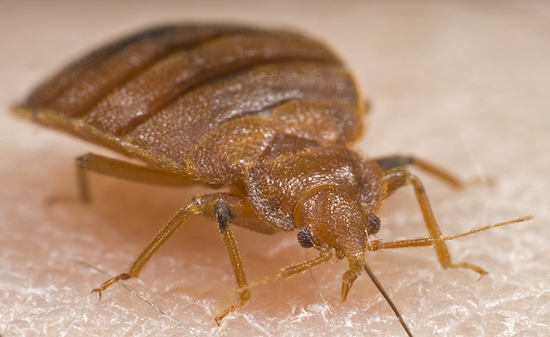
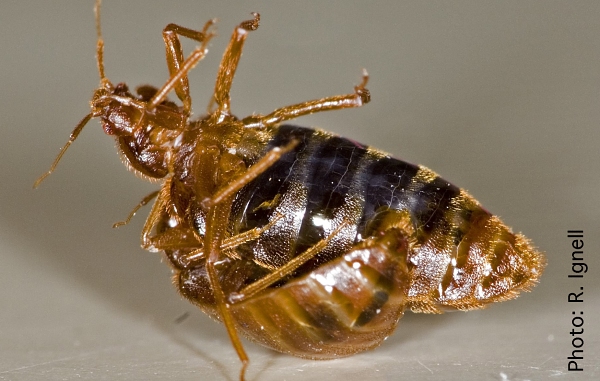
All Cimicidae mate through what is known as "traumatic insemination:" like the squids
above, a female bedbug does not receive sperm through any particular opening, leaving
the male to create one himself. In this case, the male cuts his way through the female's
exoskeleton with a sword-like, needle-tipped phallus and releases sperm directly into the
hemolymph or "blood." Females fight these violent advances as they would a predatory
attack, as the wounds can be permanently crippling and easily become infected. In some
species, females even fight back with their own identical weaponry, making them tougher
for the males to identify and leading to what scientists have dubbed "penis fencing."
Cruel though it seems to our human sensibilities, arrangements such as these ensure that
only the strongest individuals will pass on their genes. Males must be tough enough to
overcome the larger, more powerful females and females must be healthy enough to
survive their wounds. It's no wonder these insects have adapted to most pesticides at an
unprecedented rate, making a dramatic comeback where they were once thought to have
been fully eradicated.
above, a female bedbug does not receive sperm through any particular opening, leaving
the male to create one himself. In this case, the male cuts his way through the female's
exoskeleton with a sword-like, needle-tipped phallus and releases sperm directly into the
hemolymph or "blood." Females fight these violent advances as they would a predatory
attack, as the wounds can be permanently crippling and easily become infected. In some
species, females even fight back with their own identical weaponry, making them tougher
for the males to identify and leading to what scientists have dubbed "penis fencing."
Cruel though it seems to our human sensibilities, arrangements such as these ensure that
only the strongest individuals will pass on their genes. Males must be tough enough to
overcome the larger, more powerful females and females must be healthy enough to
survive their wounds. It's no wonder these insects have adapted to most pesticides at an
unprecedented rate, making a dramatic comeback where they were once thought to have
been fully eradicated.
| Adactylidium Mites: Unborn Incest and Matricidal Cannibalism |
In microscopic mites of the genus Adactylidium, the male is never born and the females
are born pregnant. You can probably figure out how this is possible on your own, but you
came here for the gruesome details and that's what you're going to get.
are born pregnant. You can probably figure out how this is possible on your own, but you
came here for the gruesome details and that's what you're going to get.
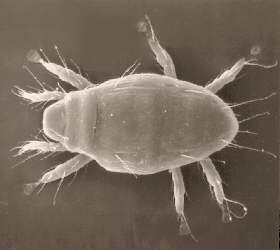
The female Adactylidium lives out her entire brief life as a parasite on the egg of a tiny
insect called a thrip (above.) Already, a single male offspring is developing in her body
with just a handful of females, who take turns copulating with their brother as they molt,
feed and grow. Soon, their dying mother is a swollen bag of discarded shells and feces,
which her daughters will rip open and devour from within. Unequipped to move or feed on
his own, the "unborn" male will die in the mother's remains almost instantly, while his
sisters scatter to find thrip eggs of their own.
insect called a thrip (above.) Already, a single male offspring is developing in her body
with just a handful of females, who take turns copulating with their brother as they molt,
feed and grow. Soon, their dying mother is a swollen bag of discarded shells and feces,
which her daughters will rip open and devour from within. Unequipped to move or feed on
his own, the "unborn" male will die in the mother's remains almost instantly, while his
sisters scatter to find thrip eggs of their own.
